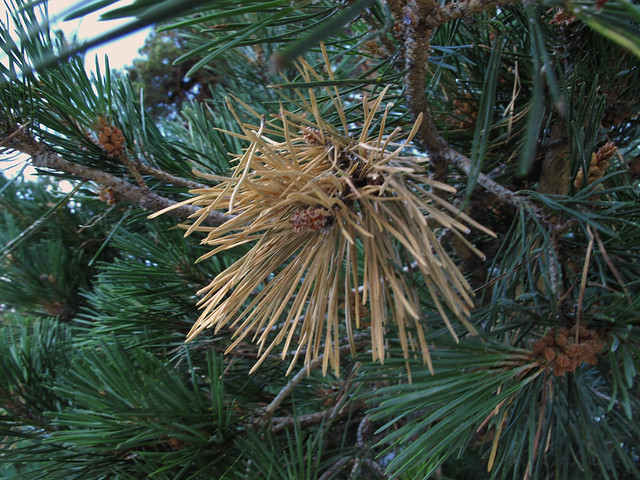This is the fourth part of a series on winter tree diseases and disorders. This article examines beech bark disease and diplodia tip blight.
Introduction
During the winter months, many of the fungal pathogens that affect trees enter dormancy. The pathogens overwinter on their hosts or in the soil, awaiting spring’s arrival. Despite the frigid temperatures, trees suffering from fungal diseases may still exhibit infection symptoms in winter, especially if the disease has advanced into its later stages. The following describes some of the most common diseases to overwinter on trees, and how they may be detected.
Beech Bark Disease
Beech bark disease is an insect-disease complex responsible for causing significant mortality and defect in American beech (Fagus grandifolia) and European beech (Fagus sylvatica). Beech bark disease results when the beech scale insect, Cryptococcus fagisuga, infiltrates and alters a tree’s bark, creating a wound. The wound allows two different fungi, Neonectria faginata or Neonectria ditissima to invade the tree, causing a canker to form. Over subsequent years, cankers continue to form, eventually killing the tree.
Hosts
Beech bark disease affects American beech and European beech.
Symptoms of Infection
The white wax secreted by the beech scale insect is the first conspicuous symptom of infection. White wooly dots will appear on roughened areas of the bark, below large branches, and beneath mosses and lichens. As the insect population increases, the entire bole of the tree may be swathed in white. Dead spots on the tree are indicative of fungal infection. On some trees, a red-brown exudate may ooze from the dead spots. This exudate is often referred to as slime flux. Perithecia will often begin to form around the dead sections of bark. On declining trees, leaves that emerge in spring will be stunted, turning a pale yellow color.
Management
- Biological control can be effective in isolated areas. A ladybird beetle, Chilocorus stigma, feeds on scale, and may be utilized to reduce insect populations. A fungus called Nematogonum ferrugineum, which parasitizes nectria fungi, can be employed to combat fungal infections.
- On high-value ornamental trees, beech scale insects can be controlled using horticultural oils. Two applications should be performed: one spraying oil application, and one larval spray application.
- Power washing trees infested with beech scale can help to minimize populations.
- Salvage cutting is the most ideal method for forested settings; this will help to prevent the spread of beech scale to other trees.
- At present, there are no treatments available for fungal infections.
Diplodia Tip Blight
Diplodia tip blight, also known as Sphaeropsis tip blight, is a common fungal disease caused by two species of Diplodia: Diplodia pinea and Diplodia scrobiculata. Diplodia pinea is the more aggressive species. Infected needles will become stunted, and die back. As blight infections spread, more needles will be killed. If left untreated, diplodia tip blight infection will eventually affect the entire crown.
Hosts
Diplodia tip blight is most common in pines that have two to three needles per bundle. Austrian pine is the most susceptible species. Other conifers, such as spruce, fir, larch and arbovitae may occasionally become infected. Pines that have five needles per bundle are highly resistant to the disease.
Symptoms of Infection
Brown, stunted, or curled new shoots, with short, brown needles may signify the presence of Diplodia tip blight. Symptoms are characterized by resin droplets, which indicate that a new shoot has been infected. Entire new shoots are killed rapidly by the fungus. Needles on infected shoots often turn tan or brown while still encased in their fascicle sheaths. Infection varies among major branches. Damage is first evident in the lower crown, before progressing upwards. Diplodia tip blight can form perennial cankers on mature trees and saplings, inducing sudden branch death. After two or three successive years of infection, the tree’s crown may incur significant damage.
Infection is most common in mature pines. Damage from Diplodia tip blight is generally confined to new shoots; however, the fungus may infect older tissues through damage resulting from wind and hail, or perforations in the wood created by insects. Tissues wounded during pruning or shearing operations may also become infected. Stressed or injured trees remain vulnerable to infection for several days, especially during warm, dry periods. Symptoms on new shoots can be detected in late May. The extent of the infection can be effectively determined in late June or July.
Management
- Infection of new shoots can be reduced by applying a fungicide to pines. Perform the first application as buds begin to swell, followed by a second application two weeks later. Fungicides applied during late April and early May will not prevent infection of seed cones.
- Prune and dispose of blighted needles, twigs, and cones. Use rubbing alcohol, or a solution comprised of one part bleach and nine parts water to disinfect pruning tools before each cut. This will help prevent the fungus from being spread to other trees or branches.
- Forego pruning or shearing of pines during periods that are favorable for infection.
- When planting, avoid selecting vulnerable conifer species in areas where infection is common. Native species are more susceptible when planted on poor soil sites, or locations prone to environmental stressors.
- Ensure trees are sufficiently watered, especially during periods of extreme heat.
- Fertilizing trees in spring or summer will improve tree vigor; avoid using fertilizers containing high quantities of nitrogen.
- Maintain a layer of mulch around the base of the tree to improve soil quality, and conserve soil moisture.
- Avoid mechanical wounding of susceptible plants.
Photo courtesy of Jacinta Iluch Valero CC-by-2.0


